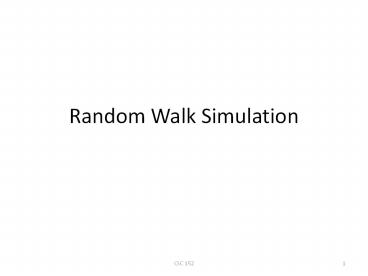Random%20Walk%20Simulation - PowerPoint PPT Presentation
Title:
Random%20Walk%20Simulation
Description:
Random Walk Simulation CSC 152 * A random walker takes follows a path each step of which is chosen at random. CSC 152 * A random walk is a model for Brownian ... – PowerPoint PPT presentation
Number of Views:239
Avg rating:3.0/5.0
Title: Random%20Walk%20Simulation
1
Random Walk Simulation
2
A random walker takes follows a path each step
of which is chosen at random.
3
A random walk is a model for Brownian motion
4
And diffusion
5
Set up for your simulation in Excel. If you type
Sample 1 and Sample 2 in consecutive cells,
highlight them and drag, Excel will update to
Sample 3, etc. Make 100 samples.
6
Enter the numbers 0, 1, , 50 in the number of
steps column. Also enter 0s for the initial
position of all 50 samples.
7
Enter the formula like F2RANDBETWEEN(-1,1).
The possible results of RANDBETWEEN(-1,1) are -1
which we will interpret as a taking a step to the
left, a 0 which we will interpret as staying in
place, and 1 which we will interpret as taking a
step to the right.
8
Copy the formula down Sample 1s column.
9
Copy the formula over to all of the sample column
(it was column DA in the example below).
10
The average over the samples should be close to
zero because samples are as likely to move to the
left as to the right. Therefore we look at
standard deviation.
Enter the formula to calculate the standard
deviation of position over the various samples.
Then copy that formula down over the various
times (number of steps).
11
Highlight the data (EXCLUDING the first point
0,0) and make an XY-Scatter
12
Choose layout 9. Choose a Power-Law fit
(Trendline). Label the axes. Add a title.
13
Compare to theory
- According to theory the standard deviation should
have a power of ½. - How close was your value to this prediction?
- What do you think you could do to improve your
results?
14
Extrapolation
- Use your formula to estimate the standard
deviation after 100 steps.
15
Calculate the skewness and kurtosis of the
various samples. Then copy the formula down for
the various times.
This is another one of those situations which
should eventually have a normal distribution.































